In today’s tutorial, we’ll check how easy it is to install the distribution.
Difficulty: ★☆☆☆☆
📜 Table of Contents
- System Requirements
- Virtualizing Nitrux
- Downloading the ISO
- Verify the ISO Integrity and Authenticity
- Flashing the ISO to the USB
- Installing Nitrux
- Nitrux Installation Process Information
- Using Secure Boot with Nitrux
- Automated Partitioning Options
- Non-automated Partitioning Options
- Full-disk Encryption in Nitrux
- Single-booting Nitrux
- Dual-booting Nitrux with Windows or other Linux distributions
- Triple-booting Nitrux, Windows, and other Linux distributions
- Troubleshooting
- System boots, but there’s no GUI
- Can’t install due to the MBR partition limit
- Can’t install due to mounted Swap partitions
- Failure to install due to an issue with rsync error code 11
- Failure to install GRUB on a Legacy BIOS computer with multiple storage devices and using the MBR partition table
- Installation is successful, but user data isn’t persistent
- Report Installation Bugs
System Requirements
To install Nitrux on your computer, check the hardware requirements below.
- 🔰 Information: As of November 2025, we only offer Nitrux as an installable x64 (or x86_64, or amd64) ISO file.
- 🔰 Information: The default user and password for the Live session are both
nitrux.
The minimum requirements specify the hardware configuration we consider necessary to run Nitrux without harming the user experience.
- 🔰 Information: We recommend at least hardware from ca. 2011-2005; see Nitrux Hardware Testing Setups.
| HW Configuration | Minimum Requirements | |
|---|---|---|
| System | Motherboard, CPU, RAM | 4 GB RAM minimum.
Any x86_64 CPU with AVX2 support (x86-64-v3). |
| EFI or UEFI without Secure Boot, or Legacy BIOS. | ||
| The motherboard must support USB boot. | ||
| Screen | VRAM | 512 MB VRAM minimum. |
| 3D Acceleration | Any GPU supported by Mesa and open-source Linux drivers, except:
All GPUs must work with Mesa GBM/KMS without vendor hacks. |
|
| NVIDIA GPUs supported by the Open Kernel Module are supported. | ||
| Storage | Type | Mechanical Hard Drive or SSD (NAND-based). |
| Capacity | 64 GB minimum. At least 7 GB free on the root partition. |
|
| Network | Internet connection | Optional for installation; required for updates. |
| Audio | Any audio device supported by the included Linux kernel. | |
The recommended requirements are to ensure that Nitrux’s user experience is optimal.
- 🔰 Information: Keep in mind that Nitrux specifically targets recent, high-performance hardware; see Nitrux Hardware Testing Setups.
| HW Configuration | Recommended Requirements | |
|---|---|---|
| System | Motherboard, CPU, RAM | 8 GB RAM minimum
Any x86_64 CPU with AVX2 support (x86-64-v3).
|
| EFI or UEFI without Secure Boot, or Legacy BIOS. | ||
Motherboard supporting USB 3.0 boot and NVMe storage.
|
||
| Screen | VRAM | 2 GB of VRAM is recommended for Wayland desktops and GPU-accelerated workloads. |
| 3D Acceleration | Any GPU supported by Mesa and open-source Linux drivers, except:
All GPUs must work with Mesa GBM/KMS without vendor hacks.
|
|
| NVIDIA GPUs supported by the Open Kernel Module are supported. | ||
| Storage | Type | NVMe SSD (PCIe 3.0 or newer) for optimal performance.
|
| Capacity | 64 GB minimum.
At least 7 GB free on the root partition. |
|
| Network | Internet connection | Optional for installation; required for updates. |
| Audio | Any audio device supported by the included Linux kernel. | |
Disclaimer: Nitrux is a Linux distribution comprised of various free and open-source software. Each program details its distribution terms in /usr/share/doc/*/copyright. Nitrux OS comes with NO WARRANTY, as permitted by law.
NVIDIA Driver Information
Since Nitrux 5.0.0, the distribution includes the NVIDIA Open Kernel Module. As mentioned above and explained below, Nitrux does not use the Nouveau MESA driver.
- 🔰 Information: As of July 18, 2024, NVIDIA has officially announced the transition to using an open-source driver. However, it does not support the same GPU architectures as the Nouveau MESA driver or NVIDIA’s Legacy/Current Proprietary driver, and isn’t entirely “open.”
- NVIDIA states: “For newer GPUs from the Turing, Ampere, Ada Lovelace, or Hopper architectures, we recommend switching to the open-source GPU kernel modules. For older GPUs from the Maxwell, Pascal, or Volta architectures, the open-source GPU kernel modules are not compatible with your platform. Continue to use the NVIDIA proprietary driver. For mixed deployments with older and newer GPUs in the same system, continue to use the proprietary driver.”
- Following NVIDIA’s deprecation of the Maxwell, Pascal, and Volta architectures in October 2025 (announced in July 2025 for Windows and eventually affecting Linux; according to this NVIDIA schedule, the 580 driver series will be the last to support those architectures), starting with Nitrux 5.0.0, the distribution will no longer use the NVIDIA Proprietary driver; instead, it will use the NVIDIA Open Kernel Module.
- NVIDIA states: “For newer GPUs from the Turing, Ampere, Ada Lovelace, or Hopper architectures, we recommend switching to the open-source GPU kernel modules. For older GPUs from the Maxwell, Pascal, or Volta architectures, the open-source GPU kernel modules are not compatible with your platform. Continue to use the NVIDIA proprietary driver. For mixed deployments with older and newer GPUs in the same system, continue to use the proprietary driver.”
- ⚠️ Important: We cannot include any NVIDIA Legacy drivers (e.g., 470, 390) alongside the current version, as NVIDIA does not support installing two drivers simultaneously (see links 1 and 2). Additionally, NVIDIA drivers before version 470 (e.g., nvidia-390) do not support hardware-accelerated XWayland, causing non-Wayland-native applications to perform poorly in Wayland sessions.
Disclaimer: Nitrux does not develop the NVIDIA Open Kernel Module. For issues with the NVIDIA driver, including bugs and adding support for graphics cards, please visit NVIDIA Support.
Virtualizing Nitrux
Starting with Nitrux 5.0.0, we have decided to discontinue integration and support features intended for running Nitrux as a guest OS. While Nitrux will continue to run in most hypervisors, components such as SPICE integration, the QXL X.Org driver, and the Hyper-V modules, daemons, and OpenRC services are no longer included.
Despite our previous efforts to provide guidance, we repeatedly encountered users applying incorrect configurations, further limiting performance in already-constrained virtualized environments, among other issues stemming from hypervisor quirks. We never intended Virtual Machines to be the platform for using Nitrux.
Nitrux is tuned and optimized for physical systems, where users can experience its design, performance, and intent as we built it.
- ⚠️ Important: Bug reports regarding running Nitrux as a guest VM will be closed.
Disclaimer: Nitrux does not develop VirtualBox, VMWare Workstation/Player, GNOME Boxes, QEMU, or Hyper-V. If you have issues with these hypervisors, such as graphical problems, please report them to their respective bug trackers.
Downloading the ISO
Of course, we need to obtain the correct ISO file to install the distribution.
We offer users various ways to download our ISO files.
- Directly from our website.
- A torrent file from FOSSTorrents.com.
- Mirrors from Sourceforge.
Once the ISO is on our computer, we should verify its integrity.

Verify the ISO Integrity and Authenticity
We include links to the ISO checksum and signature files in the release announcement that we upload to Sourceforge.
Using the Terminal (*nix)
To verify the integrity of the ISO file, run the following command.
- Using SHA512 (Nitrux 3.2.1 and newer).
sha512sum -c path_to_checksum_file.sha512
Using GtkHash (Linux)
GtkHash is a graphical application available from Flathub. After installing the application, select the ISO file.
- 🔰 Information: Check out our tutorial about software management to learn how to obtain software from Flathub.

After selecting the ISO file, open the preferences and enable SHA512.

Then, after downloading the SHA512 checksum file, paste the checksum into GtkHash and click the “Calculate” button. The application will indicate whether the checksum matches.
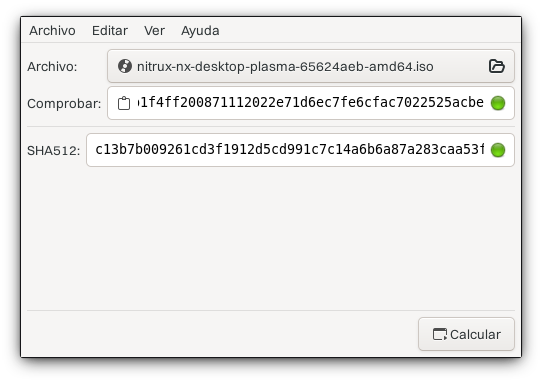
Using QuickHash-GUI (Windows)
If you’re on Windows, you can use a program like QuickHash-GUI. After installing the application, select SHA-512 as the algorithm, click the “File” tab, then click the “Select File” button and navigate to the ISO directory.
QuickHash-GUI will immediately start checking the file’s checksum.

To verify that this sum matches, download the checksum file and open it using any text editor. Then, copy the sum and paste it into the field “Expected Hash Value.” QuickHash-GUI will automatically verify the sum and display a dialog message if the verification is successful.
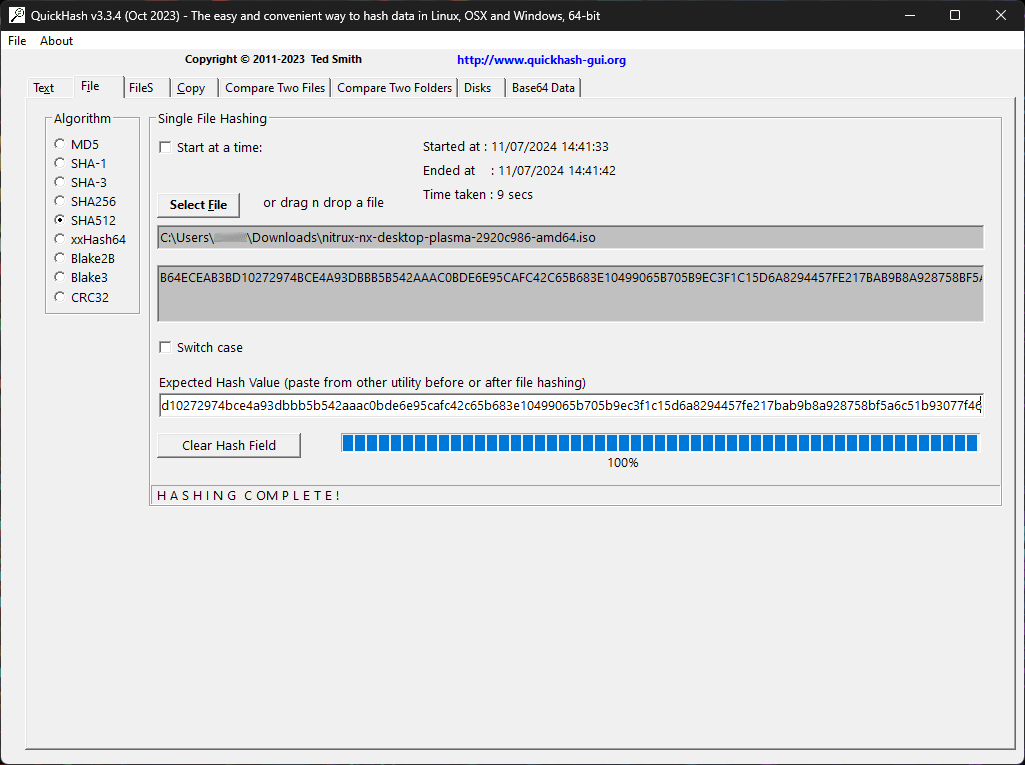
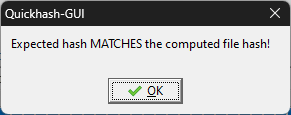
Validate the ISO Authenticity using GPG
Since Nitrux 3.2.1, our ISO images have been signed with a GPG key to ensure their authenticity. To verify the ISO’s authenticity using GPG, do the following.
- Download the ISO and the signature file.
- Import the latest public key in the latest changelog for a new release.
- Verify the signature using the command below.
gpg --verify path_to_sig_file.sig path_to_iso_file.iso
Once you have verified the integrity and authenticity of the ISO file, flash it to a USB.
Flashing the ISO to a USB
These instructions will walk you through creating a bootable Nitrux USB stick on Windows or Linux. You can use a USB stick to boot, test, or install Nitrux on any computer that supports booting from USB. The list of software below for flashing the ISO is not in any particular order of preference.
We do not recommend using the following programs to flash the Nitrux ISO to a USB drive. Issues reported caused by the software listed below will be closed, including failed flash or write operations and an unbootable Live session.
- BalenaEtcher. BalenaEtcher runs an unknown test at the end of the flashing process that consistently fails, even though it writes the image to the USB device without errors. Additionally, its users have reported severe privacy concerns about the application as it sends user data to multiple third parties.
- Unetbootin. Unetbootin does not write the image; it copies it to the USB. However, unlike Ventoy, the ISO file does not boot with Unetbootin.
- KDE ISOImageWriter. ISOImageWriter fails to write the ISO image at 99%; this is a known application issue.
- Linux Mint mintstick. Mintstick fails to write the ISO image for the target device correctly.
On the other hand, we strongly recommend using the following programs to flash our ISO file to a USB.
Rufus (Windows)
If you are using Windows and Rufus, follow these steps:
- Download a Nitrux ISO file, and download and install Rufus.
- Insert the USB flash drive into a USB port, then launch Rufus.
- Rufus will update the device within the ‘Device‘ field. If the ‘Device‘ selected is incorrect (perhaps you have multiple USB storage devices), select the correct one from the dropdown menu in the device field.
- Now, select the Boot selection. The choices will include Non-bootable, FreeDOS, Disk, or ISO image. Select “Disk or ISO image.”
- ⚠️ Important: Rufus 4.2.4070 Beta introduced a feature to the software to display a warning about revoked UEFI bootloaders, “Add detection and warning for UEFI revoked bootloaders (including ones revoked through SkuSiPolicy.p7b).” Doing this will cause Rufus to display a warning message. Users can ignore this warning, as the bootloader post-installation is signed; however, the bootloader in the ISO isn’t signed, nor are the kernels, and the distribution will not boot with Secure Boot enabled; see System Requirements.
- See this issue at the Rufus repository for context about this warning.
- Also, see this reply in a Reddit thread of the Rufus developer about their reasoning for implementing it.
- ⚠️ Important: Rufus 4.2.4070 Beta introduced a feature to the software to display a warning about revoked UEFI bootloaders, “Add detection and warning for UEFI revoked bootloaders (including ones revoked through SkuSiPolicy.p7b).” Doing this will cause Rufus to display a warning message. Users can ignore this warning, as the bootloader post-installation is signed; however, the bootloader in the ISO isn’t signed, nor are the kernels, and the distribution will not boot with Secure Boot enabled; see System Requirements.
- To select the Nitrux ISO file you downloaded previously, click SELECT to the right of “Boot selection.” If this is the only ISO file in the Downloads folder, you will see only one file listed. Select the appropriate ISO file, then click Open.
- The default selections for the Partition scheme (GPT) and Target system (UEFI (no CSM)) are appropriate (and are the only options available).
- Rufus will update the “Volume” label to reflect the ISO selected. Leave all other parameters at their default values, then click START to initiate the writing process.
- When prompted to select which mode to write this image, choose to Write in DD Image mode.
- Rufus will now write the ISO to your USB stick, and the progress bar will show your progress. With a reasonably modern machine, this should take around 10 minutes. Rufus displays the total elapsed time in the lower-right corner of the Rufus window.
- When Rufus has finished writing the USB device, the Status bar will be green-filled, and the word READY will appear in the center. Select CLOSE to complete the writing process.
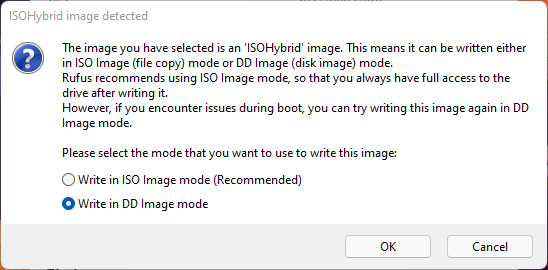
Ventoy (Windows/Linux)
If you are using Windows or Linux and Ventoy, follow these steps:
- Download a Nitrux ISO file, and install Ventoy and its GUI in the host operating system.
- ⚠️ Important: Always ensure to use the latest version available of Ventoy.
- ⚠️ Important: Ensure that Secure Boot is active in Option→Secure Boot Support.
- Using the Ventoy GUI, install Ventoy on the USB drive; this will delete all the data on the selected drive.
- Copy and paste, or cut and move, the Nitrux ISO file from the download location to the Ventoy directory on the USB drive. The directory will appear in the file manager’s sidebar.
- ⚠️ Important: Do not confuse this directory with VENTOYEFI.
- ⚠️ Important: When using Ventoy on Linux, run the command
syncto flush the USB write cache. In devices with little or no cache (like most USB thumb drives), the user must flush the cache before data is properly stored, and the kernel writes the data to the NAND flash. Ventoy does not implement any file verification method before or after the user copies or moves the ISO to the USB device. Always verify the ISO file’s checksum after copying or moving it to the Ventoy directory; see Verify the ISO Integrity and Authenticity. - ⚠️ Important: When booting our ISO file using Ventoy, if the computer has less than 4GB of RAM, select the GRUB 2 boot option in the menu; otherwise, there will be an “out of memory” error. For more information, see this issue at the Ventoy bug tracker. Additionally, check the Ventoy documentation about using the GRUB 2 boot mode.
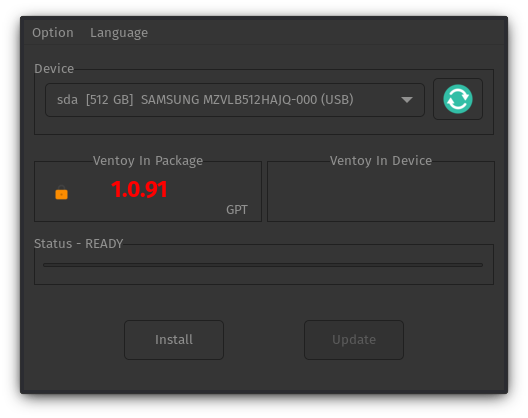
ROSA Image Writer (Windows/Linux)
If you are using Windows or Linux and ROSA Image Writer, follow these steps:
- Download a Nitrux ISO file, and install ROSA Image Writer.
- Insert the USB flash drive into a USB port, then launch ROSA Image Writer.
- Click the folder icon to browse for the Nitrux ISO file, select it, and then select the USB device from the dropdown menu.
- Click Write to initiate the writing process.

dd (*nix)
If you are using Linux and the command ‘dd,’ follow these steps:
- Download a Nitrux ISO file.
- Insert the USB flash drive into a USB port, then open a Terminal window.
- Enter the following command in the Terminal window and hit Enter.
- You must replace /dev/sdX with the correct device, such as /dev/sda,/dev/sdb, or others.
sudo dd if=nitrux.iso of=/dev/sdX oflag=sync bs=4M status=progress
Installing Nitrux
Nitrux Installation Process Information
Below is the information we deem necessary for users to read and understand before installing this distribution.
- ⚠️ Important: When adding a username, i.e., “a name for the user,” do not include spaces, special characters, or numbers. Valid characters for hostnames are ASCII letters a-z. A username may not start with a hyphen. Not following this rule will prevent the installation from continuing; this is not a Nitrux bug.
- ⚠️ Important: When adding a hostname, i.e., “a name for the computer,” do not include spaces or special characters. Valid characters for hostnames are ASCII letters from a to z, the digits from 0 to 9, and the hyphen (-). A hostname may not start with a hyphen. Not following this rule will prevent the installation from continuing; this is not a Nitrux bug.
- ⚠️ Important: Our configuration for Calamares enforces a stricter user password quality check using libpwquality, increasing user account security. When creating the main user account, i.e., the “system administrator,” users must use a password at least eight characters long, including uppercase and lowercase letters, numbers, and symbols, and ensure it is sufficiently random during installation. Otherwise, the password quality check will be too low, and the installation will not continue.
- 🔰 Information: We recommend using a password generator application (mobile or desktop) or a website. Please avoid using simple passwords, such as 1234567890aB!, as they will not pass the password quality checks (they fail the dictionary check). Alternatively, run the following command to generate a usable password directly from the Terminal.
pwgen -ys 15 1
-
-
- ⚠️ Important: Users can still use insecure passwords by turning off the password quality check via the “Enable password strength validation” checkbox, or by changing the password of the primary user account post-installation; however, we strongly recommend leaving the checkbox enabled for security reasons. Please be aware that turning off password strength validation in Calamares will not affect other user accounts created after installation; it will only affect the account created by Calamares.
-
- 🔰 Information: To view Calamares’s verbose output during installation, click the icon next to the progress bar or start Calamares from the Terminal. To start Calamares from the Terminal, run the following command.
sudo -E start-calamares
Using Secure Boot with Nitrux
When Secure Boot is enabled, we strongly recommend using Ventoy to boot the ISO. Ventoy provides documentation to enroll its key in the computer’s MOKManager. After enrolling the key and rebooting, select our ISO and use GRUB 2 Boot mode. However, the installed system will not boot if Secure Boot remains enabled since the kernel is not signed.
- ⚠️ Important: If Secure Boot is enabled and the kernel is not signed, booting will fail with an error like “Secure Boot Violation.” Some distributions, like Ubuntu, have their bootloaders (shims) signed by Microsoft’s UEFI CA, allowing them to trust their kernels without manual enrollment. Given our past interactions with Microsoft and its partners, we’re unwilling to pay Microsoft for its signing service. Users can freely generate and enroll their Machine Owner Keys (MOKs) to locally sign and boot custom kernels.
To boot the installed system using the default kernels, users must sign it with a user-generated MOK using Nitrux SB Manager after installation.
First, disable Secure Boot and boot Nitrux, then proceed to sign the kernel. Nitrux SB Manager will provide the necessary information to complete the key enrollment. Then, after enrolling the user-generated key, re-enable Secure Boot and boot Nitrux.
Alternatively, users can boot another kernel post-installation using Kernel Boot, which works with Secure Boot without additional key enrollment, such as the vanilla Debian-signed kernel; see How to use Kernel Boot.
Automated Partitioning Options
Users can select the automated partition options, such as Install alongside, Erase disk, and Replace partition. When using these options, Calamares will use our custom partition layout and create three partitions, in addition to ESP and Swap. Our partition layout uses percentages to assign partition sizes, which scale based on the storage device size, unallocated space, or the selected partition to replace. The percentages target a device with at least 64GiB of storage; for example, we assign 22% to the root directory, which means the assigned space would be 14.08GiB, leaving enough space for the root.
- The
/partition (NX_ROOT) will occupy 22%.- This partition will use the XFS filesystem. This XFS-formatted partition will use the following additional filesystem features (enabled by Nitrux™).
- Allow the filesystem to place inodes anywhere within itself. Storing an inode in the exact location as the file’s data improves performance.
- ⚠️ Important: When installing the distribution, the installation will fail if the root partition does not have enough storage space. This problem is neither a Nitrux bug nor a Calamares bug. It is possible that in Legacy BIOS devices, Calamares does not display an error when that scenario occurs; in that case, it is a bug in Calamares (not to display the error), as it does display an error message when the device uses EFI.
- ⚠️ Important: Please be aware that the root directory is immutable, and any directory within the root will be read-only. Our custom partition layout separates user-managed directories from the root.
- Allow the filesystem to place inodes anywhere within itself. Storing an inode in the exact location as the file’s data improves performance.
- This partition will use the XFS filesystem. This XFS-formatted partition will use the following additional filesystem features (enabled by Nitrux™).
- The
/homepartition (NX_HOME) will occupy 68% and the/var/libpartition (NX_VAR_LIB) will occupy 10%.- These partitions will use F2FS instead of XFS. These F2FS-formatted partitions will also use the following additional filesystem features (enabled by Nitrux™).
- Compression using zstd with compression at level 6. The primary goal is to reduce writes to extend the flash lifetime and potentially slightly increase performance; see Native File Compression in F2FS.
- Verification of compressed blocks using a checksum to avoid corruption.
- Enable a better garbage collector and asynchronous garbage collection.
- Avoid synchronously updating access or modification times to improve I/O performance and flash durability.
- Native F2FS file encryption. The filesystem applies encryption at the directory level, and different directories can use different encryption keys. To use F2FS’s native encryption support, see Native File Encryption in F2FS.
- This differs from dm-crypt, the block-device-level encryption used by Calamares during installation.
- These partitions will use F2FS instead of XFS. These F2FS-formatted partitions will also use the following additional filesystem features (enabled by Nitrux™).
- The
/boot/efiThe partition (EFI System Partition) is fixed-size (300 MB). - The
swappartition (SWAP) uses whatever space on the storage device remains.
Non-automated Partitioning Options
Users can also select Manual partitioning. However, we strongly recommend following our partition layout; otherwise, some functionality, such as upgrades and rollbacks using the Nitrux Update Tool System, will be lost.
- Select the mount point of all partitions and options (where applicable).
- We recommend adding labels to the partitions. Our recommended partition layout is below.
- Optionally, choose to encrypt the whole system (or each partition individually).
- ⚠️ Important: When creating the EFI System Partition for Legacy BIOS devices, the partition size must be 8MiB.
- 🔰 Information: Calamares will continue to display a pop-up window to the user despite creating the partition in this size and adding the required flag; this is a bug in Calamares.
- 🔰 Information: The tables below assume the target device is an x64 (x86-64, or amd64) computer using Legacy BIOS, EFI, or UEFI firmware and a GPT partition table.
- 🔰 Information: While the (new) layout below is our recommendation, users can add almost any directory they want as a separate partition. However, the root and home must be separate because the root directory is immutable.
- ⚠️ Important: Do not add the directory
/etcas a separate partition; otherwise, the system will be unbootable
- ⚠️ Important: Do not add the directory
- 🔰 Information: Please be aware that neither XFS nor F2FS partitions support downsizing, only growing.
- ⚠️ Important: When creating the EFI System Partition for Legacy BIOS devices, the partition size must be 8MiB.
The table below defines our partition layout for EFI or UEFI-based computers with GPT (GUID Partition Table) storage devices.
- ⚠️ Important: Please be aware that the root directory is immutable, and any directory within the root will be read-only. Do not use a single partition layout.
| Partition | Label | Mountpoint | Filesystem Type | Flags |
|---|---|---|---|---|
| EFI System Partition | ESP | /boot/efi | fat32 | boot |
| root | NX_ROOT | / | xfs | none |
| home | NX_HOME | /home | f2fs | none |
| /var/lib | NX_VAR_LIB | /var/lib | f2fs | none |
| swap | SWAP | none (automatically set up) | linuxswap | swap |
The table below defines our partition layout for Legacy BIOS computers with GPT (GUID Partition Table) storage devices.
- ⚠️ Important: Please be aware that the root directory is immutable, and any directory within the root will be read-only. Do not use a single partition layout.
| Partition | Label | Mountpoint | Filesystem Type | Flags |
|---|---|---|---|---|
| EFI System Partition | – | – | unformatted | bios-grub |
| root | NX_ROOT | / | xfs | none |
| home | NX_HOME | /home | f2fs | none |
| /var/lib | NX_VAR_LIB | /var/lib | f2fs | none |
| swap | SWAP | none (automatically set up) | linuxswap | swap |
Full-disk Encryption in Nitrux
We have added the ability for users to perform full-disk encryption with dm-crypt during installation via the Calamares installer.
- During early boot, the system will ask the user for their passphrase, unlocking all encrypted partitions.
- Block-device encryption during installation is in addition to any userland tool (such as fscrypt); see File Encryption in Nitrux.
The checkbox to encrypt the installation is only visible when selecting the automated options in the partitions module, such as Install alongside, Erase disk, and Replace partition. When selecting Manual partitioning, the user must use a new partition—not edit an existing partition—to make the checkbox visible in the individual partition setup window.
Single-booting Nitrux
To install Nitrux as the single operating system, do the following steps:
- Disable Secure Boot using your device’s firmware, as noted in System Requirements.
- After disabling Secure Boot, select “Erase disk,” click the “Next” button, then confirm the installation when asked.
Dual-booting Nitrux with Windows or other Linux distributions
To install Nitrux alongside Windows, do the following steps:
- Disable Secure Boot using your device’s firmware, as noted in System Requirements.
- After disabling Secure Boot, do either of the following:
- Boot the Nitrux ISO, launch the installer, select “Install alongside,” and click on an existing Windows NTFS partition with sufficient space. Adjust the slider to determine how much to allocate for Nitrux.
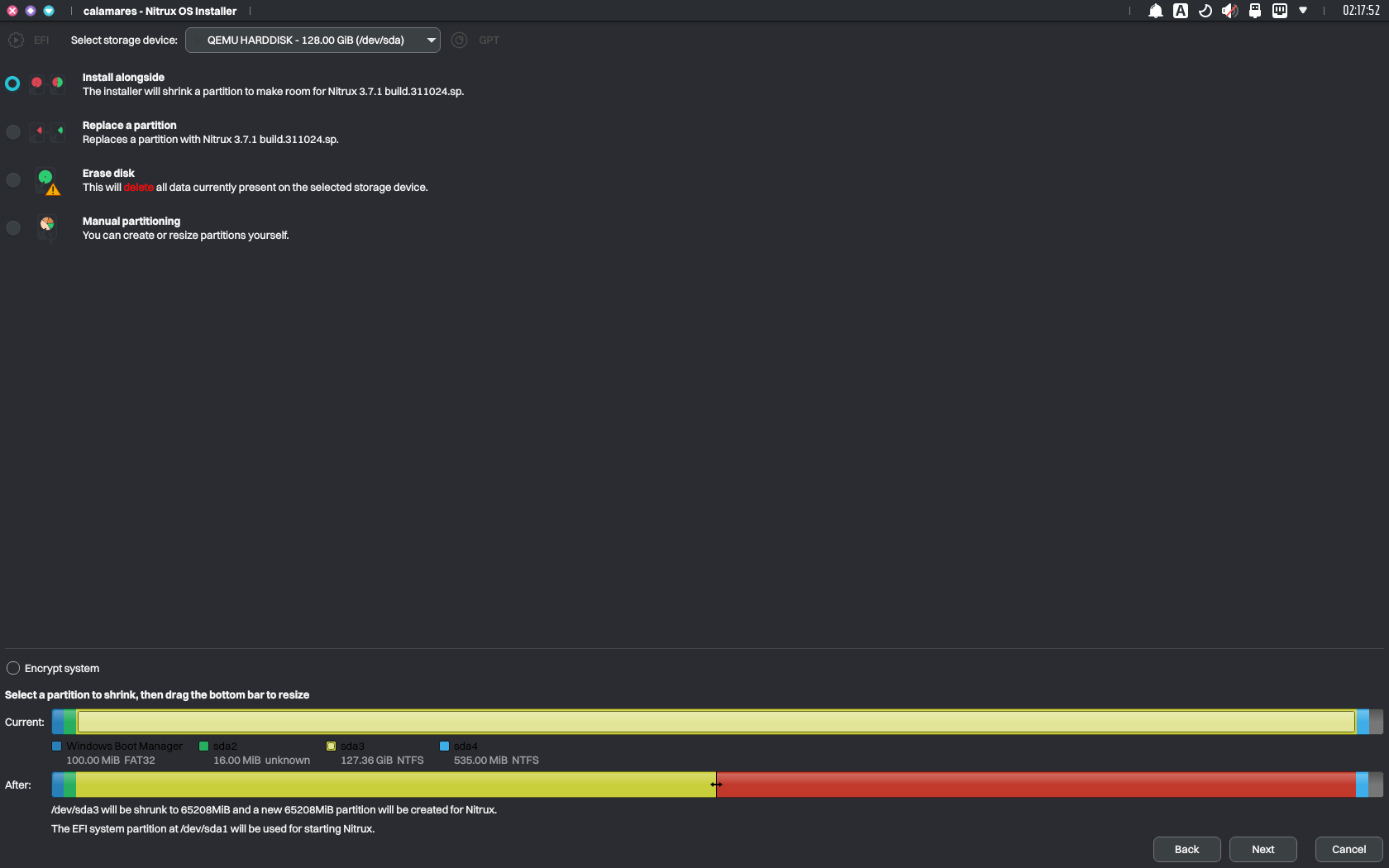
Allocating storage space to install Nitrux within Calamares. Image for reference.
- Boot into Windows and use Disk Management to shrink a partition in your storage device to create unallocated space, or boot the Nitrux ISO, launch KDE Partition Manager, and shrink an existing partition to create unallocated space. Then, launch the installer, select “Replace partition,” and click the unallocated space.
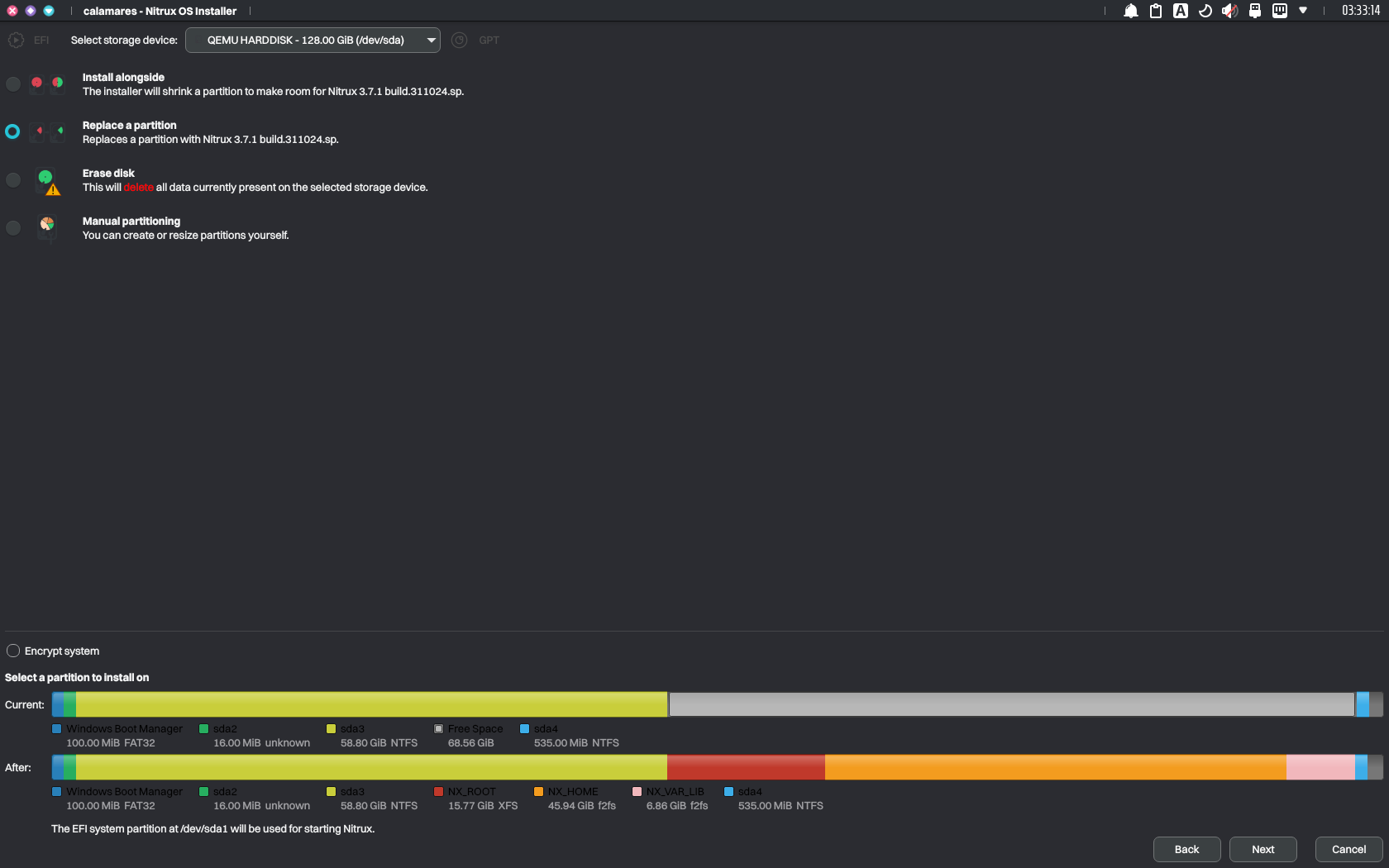
Using unallocated space to install Nitrux. Image for reference.
- Alternatively, select “Manual partitioning” and follow the partition layout table that best fits your device as described in Non-automated Partitioning Options.
- ⚠️ Important: Please be aware that the root directory is immutable, and any directory within the root will be read-only. Do not use a single partition layout.
Regardless of the selection, once the installation is complete, GRUB will display entries to boot into Nitrux or Windows (Windows Boot Manager) upon reboot.
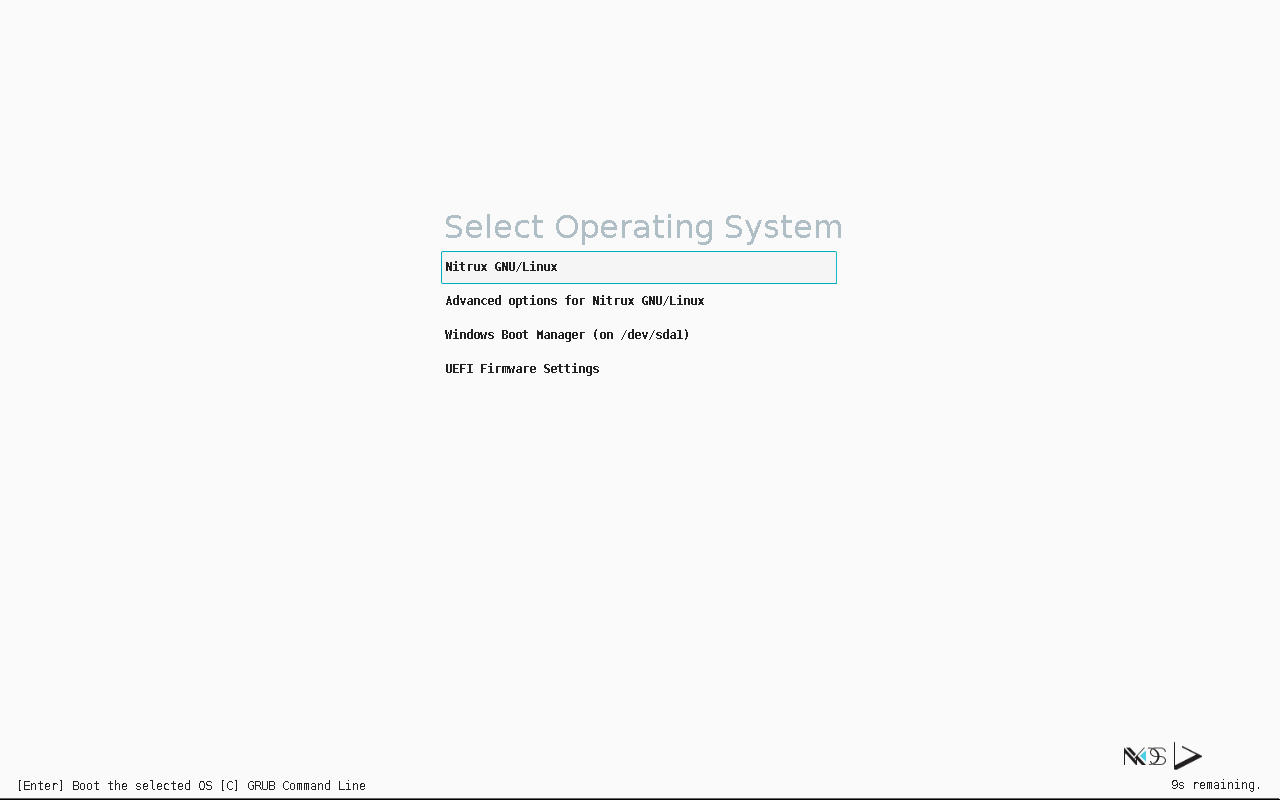
Upon rebooting, GRUB will display an entry for the Windows Boot Manager. Image for reference.
Installing Nitrux alongside other Linux distributions is precisely the same process as above.
- Disable Secure Boot using your device’s firmware, as noted in System Requirements.
- After disabling Secure Boot, do either of the following:
- Boot the Nitrux ISO, launch the installer, select “Install alongside,” and click on an existing partition with sufficient space. Adjust the slider to determine how much to allocate for Nitrux.
- Boot the Nitrux ISO, launch KDE Partition Manager, and shrink an existing partition to create unallocated space. Then, launch the installer, select “Replace partition,” and click the unallocated space.
- Alternatively, select “Manual partitioning” and follow the table that best fits your device as described in Non-automated Partitioning Options.
Regardless of the selection, once the installation is complete, GRUB will display entries to boot into Nitrux or the other Linux distribution at reboot.
Triple-booting Nitrux, Windows, and other Linux distributions
Installing Nitrux alongside Windows and other Linux distributions follows the same process as above.
- Assuming Windows is already present, install the other Linux distribution before installing Nitrux.
- Disable Secure Boot using your device’s firmware, as noted in System Requirements.
- After disabling Secure Boot, do either of the following:
- Boot the Nitrux ISO, launch the installer, select “Install alongside,” and click on an existing partition with sufficient space. Adjust the slider to determine how much to allocate for Nitrux.
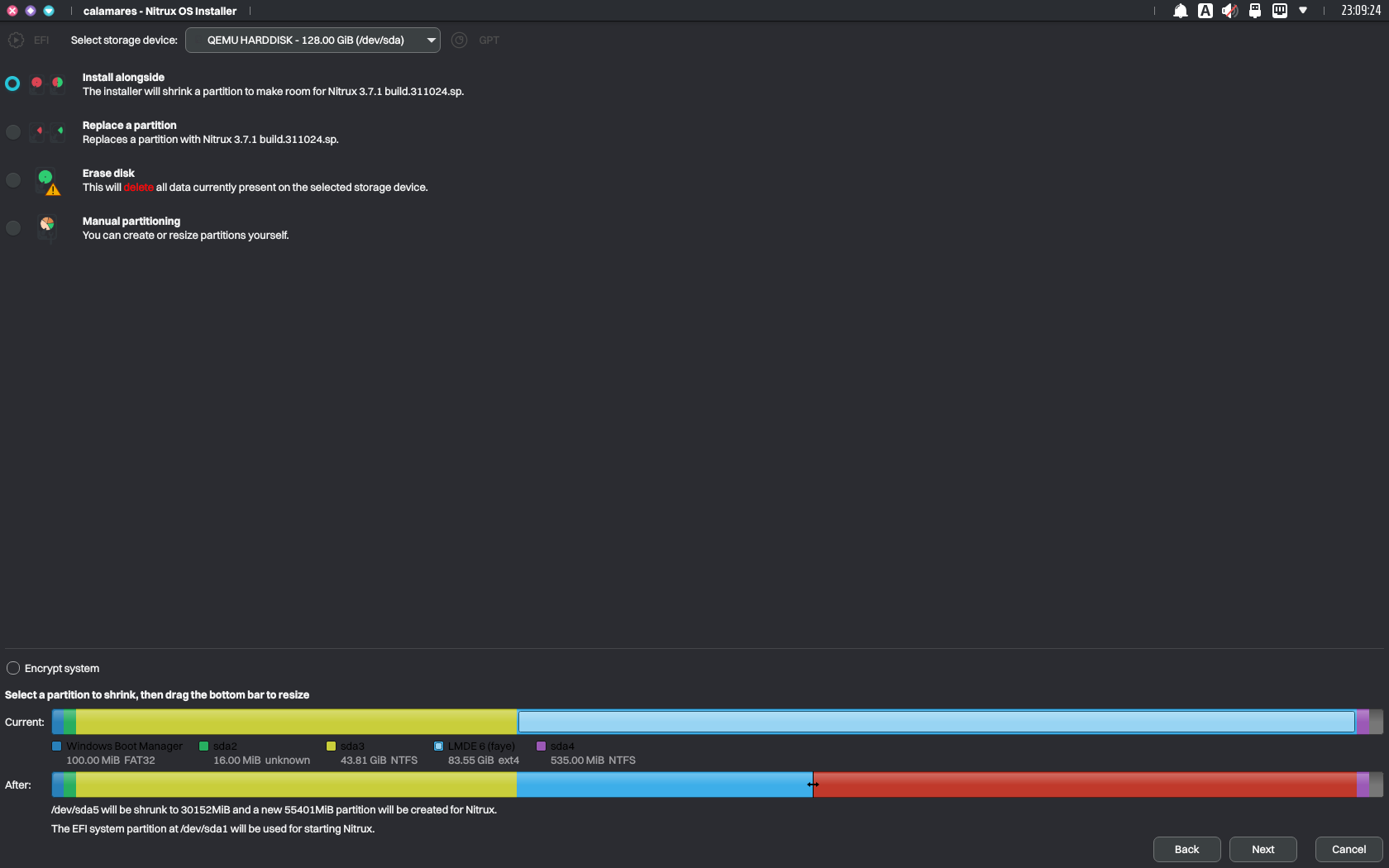
As before, use the slider to allocate storage space to install Nitrux within Calamares. Image for reference.
-
- Boot the Nitrux ISO, launch KDE Partition Manager, and shrink an existing partition to create unallocated space. Then, launch the installer, select “Replace partition,” and click the unallocated space.

Using unallocated space to install Nitrux. Image for reference.
-
- Alternatively, select “Manual partitioning” and follow the partition layout table that best fits your device as described in Non-automated Partitioning Options.
- ⚠️ Important: Please be aware that the root directory is immutable, and any directory within the root will be read-only. Do not use a single partition layout.
- Alternatively, select “Manual partitioning” and follow the partition layout table that best fits your device as described in Non-automated Partitioning Options.
Regardless of the selection, once the installation is complete, GRUB will display entries to boot into Nitrux, Windows (Windows Boot Manager), and other Linux distributions upon reboot.
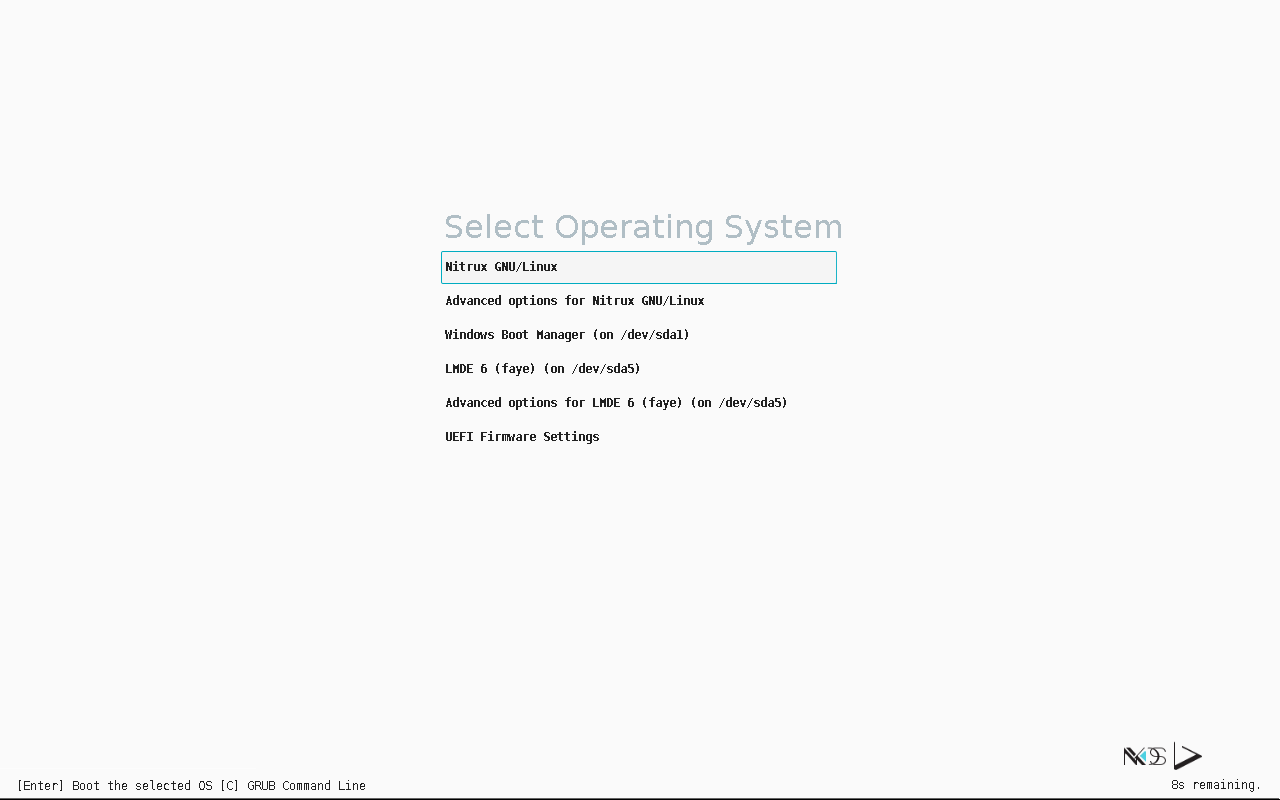
Upon rebooting, GRUB will display an entry for the available OSes. Image for reference.
Disclaimer: We do not develop the Calamares installer. To request features or report problems, please create issues at its bug tracker.
Troubleshooting
If you are unable to boot the Live ISO or complete the installation, please consult the scenarios below.
System boots, but there’s no GUI
This problem generally indicates a mismatch between your hardware capabilities and the software requirements for Nitrux. Please verify if your hardware falls into one of these categories:
- Unsupported CPU Instruction Set (AVX2): Nitrux requires a processor compatible with x86-64-v3 (AVX2 support) for the compiled Hyprland executable we use; this naturally excludes legacy hardware, even before considering RAM.
- A CPU is likely too old if the logs mention
invalid opcodeorillegal hardware instruction.- Intel: Haswell (4th Gen) and newer support AVX2.
- ⚠️ Important: Ivy Bridge and older are unsupported.
- AMD: “Bristol Ridge” A-Series (9000-series), specific late “Excavator” models, Ryzen (1st Gen) and newer support AVX2.
- ⚠️ Important: AMD FX, Phenom II, and older Socket FM2/FM2+ A-Series (Kaveri, Richland, Trinity) are unsupported.
- Intel: Haswell (4th Gen) and newer support AVX2.
- Other symptoms include a blinking cursor on a black screen (no messages) since Nitrux uses Hyprland to launch the greeter [a.k.a, login manager] (QtGreet).
- A CPU is likely too old if the logs mention
- Legacy GPU Issues: Older AMD Radeon cards (R7 240/250, HD 7000 series) with GCN 1.0 architecture, and NVIDIA cards not supported by the Open Kernel Module, may fail to launch the Wayland compositor.
- AMD GPU Issues (GCN 1.0): GCN 1.0 hardware needs compositor and driver workarounds to run under Wayland (e.g., forcing software cursors or disabling atomic modesetting). These adjustments degrade performance on modern GPUs, so Nitrux doesn’t support them. Users who still wish to run such hardware may add these workarounds manually.
- NVIDIA GPU Issues (Pascal, Volta, Maxwell, and older): NVIDIA only supports architectures from Turing onwards with the Open Kernel Module due to older architectures lacking a GSP; there are no workarounds for this.
- Insufficient RAM: Nitrux makes full use of modern memory capacities. While Hyprland itself can start with much less than 1 GB of RAM, the overall session may behave inconsistently on systems that fall short of our suggestions.
- 🔰 Information: In low-memory environments, Nitrux will still boot and run, and its performance optimizations—caching, compression, and memory tuning—help maintain usability even under pressure. However, these systems cannot fully leverage the optimizations, and the overall experience will not reflect the performance we designed Nitrux to deliver on modern hardware with more RAM.
Can’t install due to the MBR partition limit
We strongly discourage using an MBR (Master Boot Record) storage device when installing Nitrux due to the limitations of this partition table: MBR supports only four primary partitions, and Calamares won’t be able to continue the installation. We strongly suggest using a different storage device for Nitrux installation that does not use MBR, deleting the partition table, and using GPT (GUID Partition Table) instead. Alternatively, visit this AskUbuntu link to learn how to convert the partition table from MBR to GPT without data loss. This problem is neither a Nitrux bug nor a Calamares bug.
As noted in the tables, Calamares fully supports using a GUID Partition Table for EFI/UEFI and Legacy BIOS firmware types on computers. Also, be aware that deleting the partition table will delete the data on the storage device.
Can’t install due to mounted Swap partitions
In certain circumstances, such as virtualized environments, the system may automatically mount Swap partitions during a Live session boot. Calamares does not unmount Swap partitions automatically unless it’s started like this:
sudo -E start-calamares
Note that running Calamares directly, i.e., sudo calamares will not unmount Swap partitions, and if the target device has mounted partitions, the installation will not continue.
Failure to install due to an issue with rsync error code 11
As we have indicated numerous times in the Nitrux Installation Process Information section, Nitrux uses a custom partition layout with fixed percentages that scale with the device’s size or the allocated space. Failing to provide sufficient storage for the root partition will prevent the installation from finalizing, as we mentioned in this issue in our bug tracker; this is neither a bug in Nitrux nor in Calamares.
Failure to install GRUB on a Legacy BIOS computer with multiple storage devices and using the MBR partition table
When installing Nitrux on a computer with multiple available storage devices and using an MBR disk as the installation target, Calamares may not select the same device, resulting in an error during GRUB installation. As mentioned, we strongly discourage using MBR storage devices, as Calamares supports GPT on Legacy BIOS computers.
Users who choose to continue the installation despite our recommendations must ensure that the disk with the MBR partition table is the same disk on which Calamares will install Nitrux. Otherwise, Calamares will fail to install GRUB. This discrepancy in the target device selection is a bug in Calamares since this is not a configurable option.
Installation is successful, but user data isn’t persistent
Users who choose to create partitions manually should understand the following to avoid an erroneous partitioning setup that can cause data persistence problems in user-managed directories.
⚠️ Important: The root directory is immutable; any directory within the root will be read-only. Do not use a single partition layout. Follow the partition layout table that best fits your device as described in Non-automated Partitioning Options.
This problem is neither a Nitrux bug nor a Calamares bug.
Report Installation Bugs
To report problems with Calamares during installation, please use our bug tracker on GitHub and include the file ~/.cache/calamares/session.log in a bug report.
- 🔰 Information: This file is only available during the live session.
That’s it; this concludes today’s tutorial.
